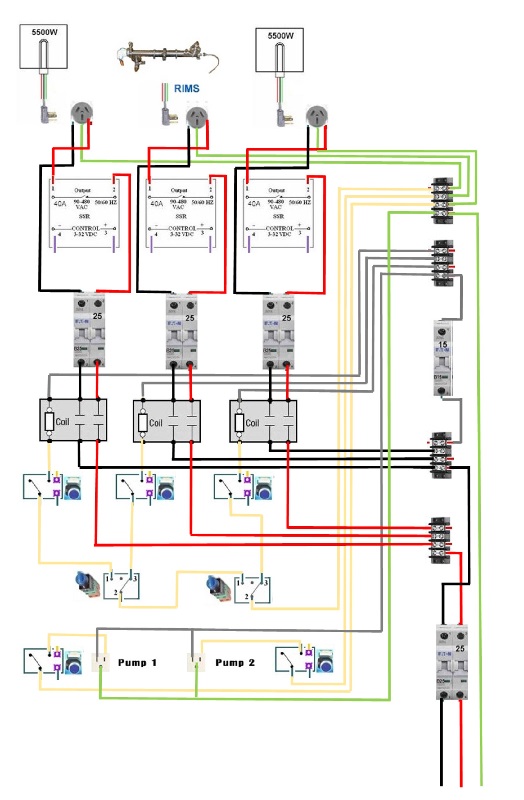I have 120v between SSR terminal 1 and ground but not on terminal 2.
Can you explain this in more detail? A diagram or picture would help.

I have 120v between SSR terminal 1 and ground but not on terminal 2.
What are people here using to produce electrical diagrams?















I currently only have a 3-wire 240v setup so figured the ground could act as a neutral.
I have 240v on the other side of the switch when on (120v each side to ground and 240v between the two hots). Will have to give the 9v to the SSR a shot. Wasn't sure that was possible.
using neutral as ground in a 3 wire box is fine just don't ground your dc ground on the ssr to, it will fry your ssr

I put a 9v on the SSR and it comes on and the element works. Hmmm, any settings on the Auber to specify the outgoing voltage? I do not have a PTD sensor hooked up to it yet but have it on power mode. Would that mater?I've never tried to use a ground line as a neutral, but since they are bonded at the panel I guess it would work?
You have confirmed 240 at source? (And 120 across the phases at the source?)
Can you put a 9V battery on the SSR terminals and see if you get 240 out of the ssr?
I put a 9v on the SSR and it comes on and the element works. Hmmm, any settings on the Auber to specify the outgoing voltage? I do not have a PTD sensor hooked up to it yet but have it on power mode. Would that mater?
I'm using a mypin PID (not aubers unit that is the topic of this thread) but I wired up my panel last night and for the life of me couldn't figure out why the ssr wasn't firing. Turns out I had the "-" SSR out pin from the PID going to the "+" terminal on the SSR itself. Flipped those wires around this morning and everything is working swimmingly.


I've triple checked that and even swapped them just to be sure. Still nothing.
I would expect to get a voltage reading from post 6 or 7 but it reads 0. Thinking it has to be that I don't have a TC hooked up to it. Mine is on the way but is a week out. Anyway to turn off the Temp reading or short the RTD input? I just want to control power to my BK.
I've triple checked that and even swapped them just to be sure. Still nothing.
I would expect to get a voltage reading from post 6 or 7 but it reads 0. Thinking it has to be that I don't have a TC hooked up to it. Mine is on the way but is a week out. Anyway to turn off the Temp reading or short the RTD input? I just want to control power to my BK.
Anybody use this in a HERMS setup? My plan is this: propane for bringing mash tun and HLT up to or close to temp, then use 120v element in HLT to fine regulate temp while using continuous recirculation. I am wondering how responsive this controller is in this situation when the temp is measured in MT and heat control is happening in HLT with the heating element and herms coil. I am currently doing this manually with propane and reading my analog thermometers, and I would like to automate the heat control so I can set and forget, and of course control temp more precisely.
Couldn't you use the relay settings on the DSPR300 to control a pump that recirculates to maintain mash temps? As long as the HLT was hotter than the mash the relay could turn the pump on to raise the temp then turn the pump off once the set point was obtained.

Couldn't you use the relay settings on the DSPR300 to control a pump that recirculates to maintain mash temps? As long as the HLT was hotter than the mash the relay could turn the pump on to raise the temp then turn the pump off once the set point was obtained.
Other than temp control, aren't there more benefits to having constant recirculation throughout the mash?

Any chance that what you are seeing is latch up (getting stuck on) with your SSR, and not a problem with the control signal from the EZBoil? Do you have an indicator lamp wired in parallel with your element? Such a lamp is very helpful for diagnosing SSR issues.I have a question with this. I have been testing it a couple times after installing this with just water/cleaning cycles. But, I am having an issue with step mashing. When I get a target temp it holds it great after I changed offshoot to 1. But, when I try to step mash and bring the temp up sometimes it will keep the element on instead of cycling on and off. If I unplug the element and plug it back in everything is perfectly fine again cycling etc. I have a 5500 Watt element from Brewhardware and I use a 2 vessel Rims system Mashtun / HLT and Boil Kettle. I did see there is a setting where once the timer is over in mashing it will start to heat up for boiling, but I have that turned off (mashing ending options). I have been racking my brain and can't figure it out.
